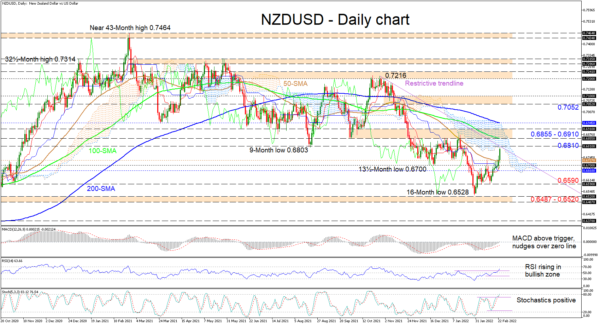NZDUSD is set to confront the Ichimoku cloud’s lower band, which intersects with a potential restrictive trend line pulled from the 0.7216 high, putting the durability of the progressive price bounce from the 16-month low of 0.6528 to the test. The longer-term 100- and 200-day simple moving averages (SMAs) are defending a more than three-month decline, while the calmer downward slope of the 50-day SMA is reflecting buyers’ recent efforts to oppose the negative picture.
The red Tenkan-sen line is indicating the latest increase in positive forces, while the blue Kijun-sen line has yet to show that downward pressures have fully abated. The short-term oscillators suggest bullish momentum is growing. The MACD, which continues to climb north of its red trigger line, has pushed beyond the zero threshold, while the RSI is heading for the 70 overbought level. Moreover, the positively charged stochastic oscillator is implying additional gains in the pair.
As mentioned in the beginning of the article, initial upside limitations could transpire from the cloud’s floor around the 0.6810 barrier, which is overlapped by the diagonal resistance drawn from the 0.7216 high. If the three-week climb from the 0.6528 trough pushes higher into the cloud, the 0.6855-0.6910 fortified resistance border could try to impede additional advances from challenging the descending 200-day SMA at 0.6945. That said, a successful jump beyond the 200-day SMA may cheer buyers to aim for the 0.7052-0.7100 next resistance obstacle.
Alternatively, if gains are capped by the cloud and the 0.6810 barrier, support could commence between the 50-period SMA at 0.6727 and the 0.6700 hurdle. If a more profound retreat unfolds beneath the neighbouring Ichimoku lines, the bears may then target the 0.6590 low before pursuing the 0.6528 trough and adjacent 0.6487-0.6520 base, which extends back to mid-July 2020.
Summarizing, NZDUSD’s bearish bias is being contested by buyers who have managed, in the last three-weeks, to pilot towards the Ichimoku cloud. The bulls could significantly revive upside momentum with a climb north of the cloud, while failing to do so, may prolong dominance of bearish pressures.














